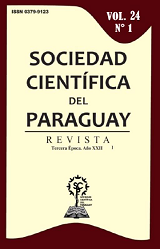Morphological characterization of fruits and seed quality of selected seed trees of Cariniana estrellensis (Raddi) Kuntze
DOI:
https://doi.org/10.32480/rscp.2019-24-1.36-47Keywords:
Forest seeds, forest restoration, matrix trees, native species, Atlantic forestAbstract
The objective of this work was to perform the morphological characterization of fruits and to determine the quality of Cariniana estrellensis seeds collected from different matrix trees. The fruits were collected from four trees located in the Mbaracayú Forest Nature Reserve, and received coding according to their common name (Ka'i Ka'ygua) and tree number: KAKA2, KAKA7, KAKA9 and KAKA11. For the morphological characterization of fruits, the length (L), upper diameter (DS), medium diameter (DM) and lower diameter (DI) of the fruits were measured (cm). To determine the amount of seeds per fruit, ten fruits were taken randomly from each batch and their seeds counted. The analysis of purity, moisture content, germination percentage were carried out and the germination speed index was calculated. In the morphological characterization of the fruits, highly significant differences were observed for: L, DS and DM, while the DI did not present significant differences, as did the number of seeds per fruit. The germination percentage presented significant differences, the highest germination percentage was obtained in KAKA2, (66%), while in KAKA9 10% was obtained. Among the germination speed indexes (IVG) of each batch, there were significant differences, KAKA2 presented an IVG of 2.33 at 14 days while the lowest index was for KAKA9 (0.35). A marked difference was observed in the length of the Cariniana estrellensis fruits, as well as in the upper and lower diameter. The germination percentage and the IVG presented values still considered low.
Metrics
Downloads
References
2. Dianderas AA, Fassbender D. Arboles semilleros arboles plus: consideraciones básicas para la selección y manejo de árboles semilleros. Boletín de divulgación técnica. Universidad Nacional Agraria La Molina: Lima, Perú; 2012.
3. Vallejos J, Badilla Y, Picado F, Murillo O. Metodología para la selección e incorporación de árboles plus en programas de mejoramiento genético forestal. Revista Agronomía Costarricense. 2010;34(1):105-119.
4. Pérez–García B, Mendoza A. Morfología vegetal neotropical. Revista Biología Tropical. 2002;50:893–902.
5. Lorenzi, H. Árvores Brasileiras: Manual de Identificação e cultivo de plantas arbóreas nativas do Brasil. 7 ed. São Paulo, Brasil; 2016.
6. López JÁ, Little LE, Ritz G, Rombold JS, Honhn WJ. Árboles comunes del Paraguay: ñande yvyra mata kuera. 2 ed. Asunción, Paraguay: Cuerpo de Paz; 2002. .
7. Brasil. Ministério da Agricultuta, Pecuaria e Abastecimiento. Regras para Análise de sementes. Brasilia, MAPA/ACS; 2009.
8. Lima Junior MJV, editor. Manual de Procedimentos para Análise de Sementes Florestais, UFAM. Manaus-Amazonas, Brasil; 2010. 146 p.
9. Brasil, Ministério da Agricultura, Pecuária e Abastecimento. Instruções para análise de sementes de espécies florestais, Brasília: MAPA; 2013. 98 p.
10. Ferreira DF. Sisvar: A computer statistical analysis system. Ciência e Agrotecnologia. 2011;35(6):1039-1042.
11. Carvalho PER. Espécies arbóreas brasileiras. Brasília: Embrapa Informação Tecnológica; 2003.
12. Marcos-Filho, J. Fisiologia de sementes de plantas cultivadas. Piracicaba: FEALQ; 2005.
13. Fowler AJP, Bianchetti A. Dormência em sementes florestais. Colombo: Embrapa Florestas; 2000.
14. Brüning, FO, Lúcio, ADC, Muniz, MFB. Padrões para germinação, pureza, umidade e peso de mil sementes em análises de sementes de espécies florestais nativas do Rio Grande do Sul. Ciência Florestal. 2011;21(2):193-202
Downloads
Published
Issue
Section
License
El/los autores autorizan a la Revista de la Sociedad Científica del Paraguay a publicar y difundir el articulo del cual son autores, por los medios que considere apropiado.


















